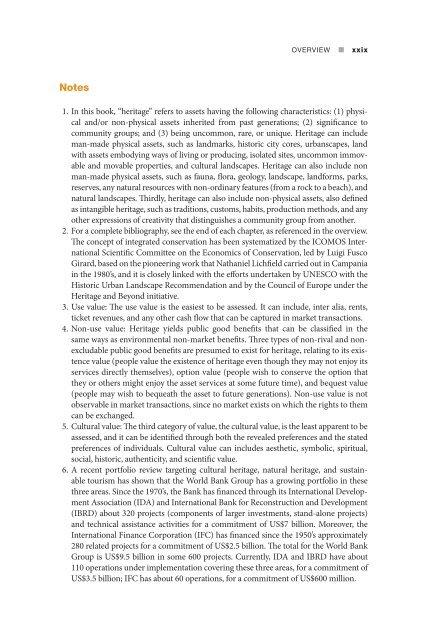ECONOMICS UNIQUENESS
ECONOMICS UNIQUENESS
ECONOMICS UNIQUENESS
Create successful ePaper yourself
Turn your PDF publications into a flip-book with our unique Google optimized e-Paper software.
Notes<br />
OVERVIEW ■ xxix<br />
1. In this book, “heritage” refers to assets having the following characteristics: (1) physical<br />
and/or non-physical assets inherited from past generations; (2) signifi cance to<br />
community groups; and (3) being uncommon, rare, or unique. Heritage can include<br />
man-made physical assets, such as landmarks, historic city cores, urbanscapes, land<br />
with assets embodying ways of living or producing, isolated sites, uncommon immovable<br />
and movable properties, and cultural landscapes. Heritage can also include non<br />
man-made physical assets, such as fauna, fl ora, geology, landscape, landforms, parks,<br />
reserves, any natural resources with non-ordinary features (from a rock to a beach), and<br />
natural landscapes. Th irdly, heritage can also include non-physical assets, also defi ned<br />
as intangible heritage, such as traditions, customs, habits, production methods, and any<br />
other expressions of creativity that distinguishes a community group from another.<br />
2. For a complete bibliography, see the end of each chapter, as referenced in the overview.<br />
Th e concept of integrated conservation has been systematized by the ICOMOS International<br />
Scientifi c Committee on the Economics of Conservation, led by Luigi Fusco<br />
Girard, based on the pioneering work that Nathaniel Lichfi eld carried out in Campania<br />
in the 1980’s, and it is closely linked with the eff orts undertaken by UNESCO with the<br />
Historic Urban Landscape Recommendation and by the Council of Europe under the<br />
Heritage and Beyond initiative.<br />
3. Use value: Th e use value is the easiest to be assessed. It can include, inter alia, rents,<br />
ticket revenues, and any other cash fl ow that can be captured in market transactions.<br />
4. Non-use value: Heritage yields public good benefi ts that can be classifi ed in the<br />
same ways as environmental non-market benefi ts. Th ree types of non-rival and nonexcludable<br />
public good benefi ts are presumed to exist for heritage, relating to its existence<br />
value (people value the existence of heritage even though they may not enjoy its<br />
services directly themselves), option value (people wish to conserve the option that<br />
they or others might enjoy the asset services at some future time), and bequest value<br />
(people may wish to bequeath the asset to future generations). Non-use value is not<br />
observable in market transactions, since no market exists on which the rights to them<br />
can be exchanged.<br />
5. Cultural value: Th e third category of value, the cultural value, is the least apparent to be<br />
assessed, and it can be identifi ed through both the revealed preferences and the stated<br />
preferences of individuals. Cultural value can includes aesthetic, symbolic, spiritual,<br />
social, historic, authenticity, and scientifi c value.<br />
6. A recent portfolio review targeting cultural heritage, natural heritage, and sustainable<br />
tourism has shown that the World Bank Group has a growing portfolio in these<br />
three areas. Since the 1970’s, the Bank has fi nanced through its International Development<br />
Association (IDA) and International Bank for Reconstruction and Development<br />
(IBRD) about 320 projects (components of larger investments, stand-alone projects)<br />
and technical assistance activities for a commitment of US$7 billion. Moreover, the<br />
International Finance Corporation (IFC) has fi nanced since the 1950’s approximately<br />
280 related projects for a commitment of US$2.5 billion. Th e total for the World Bank<br />
Group is US$9.5 billion in some 600 projects. Currently, IDA and IBRD have about<br />
110 operations under implementation covering these three areas, for a commitment of<br />
US$3.5 billion; IFC has about 60 operations, for a commitment of US$600 million.


